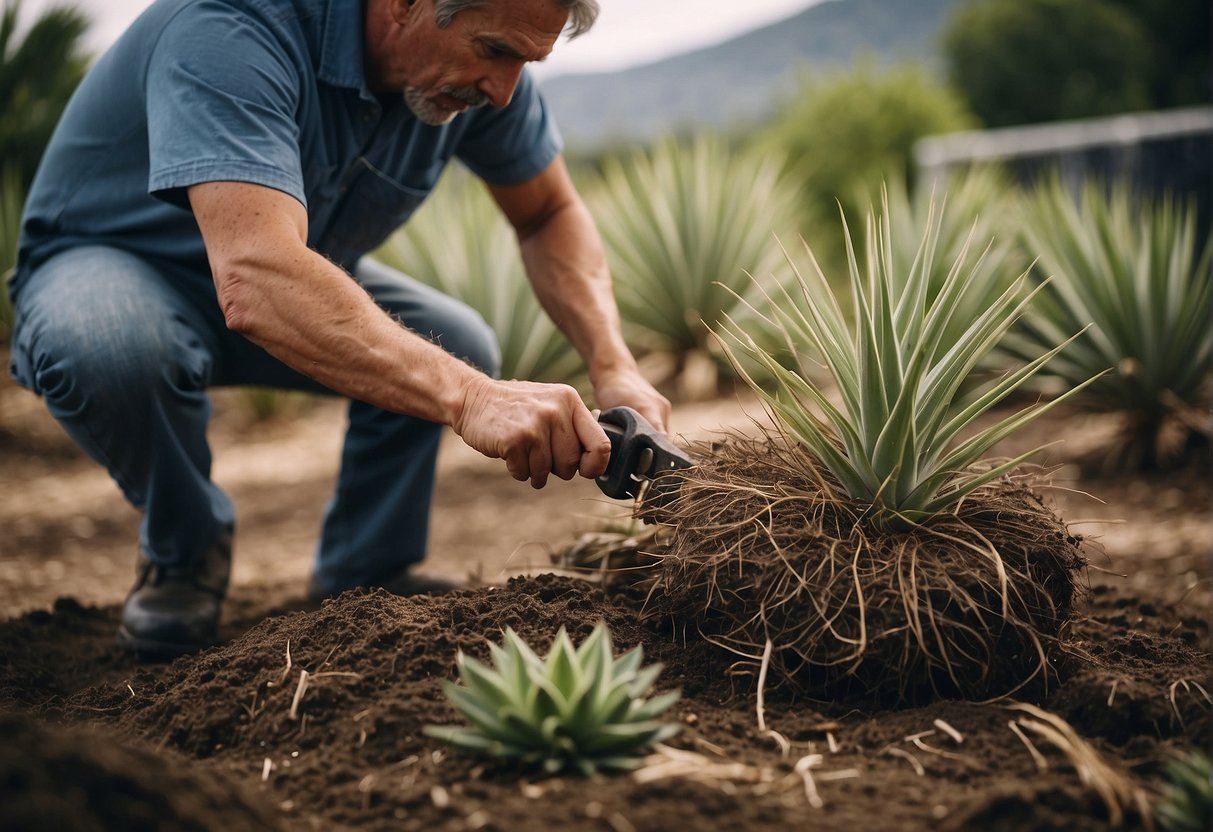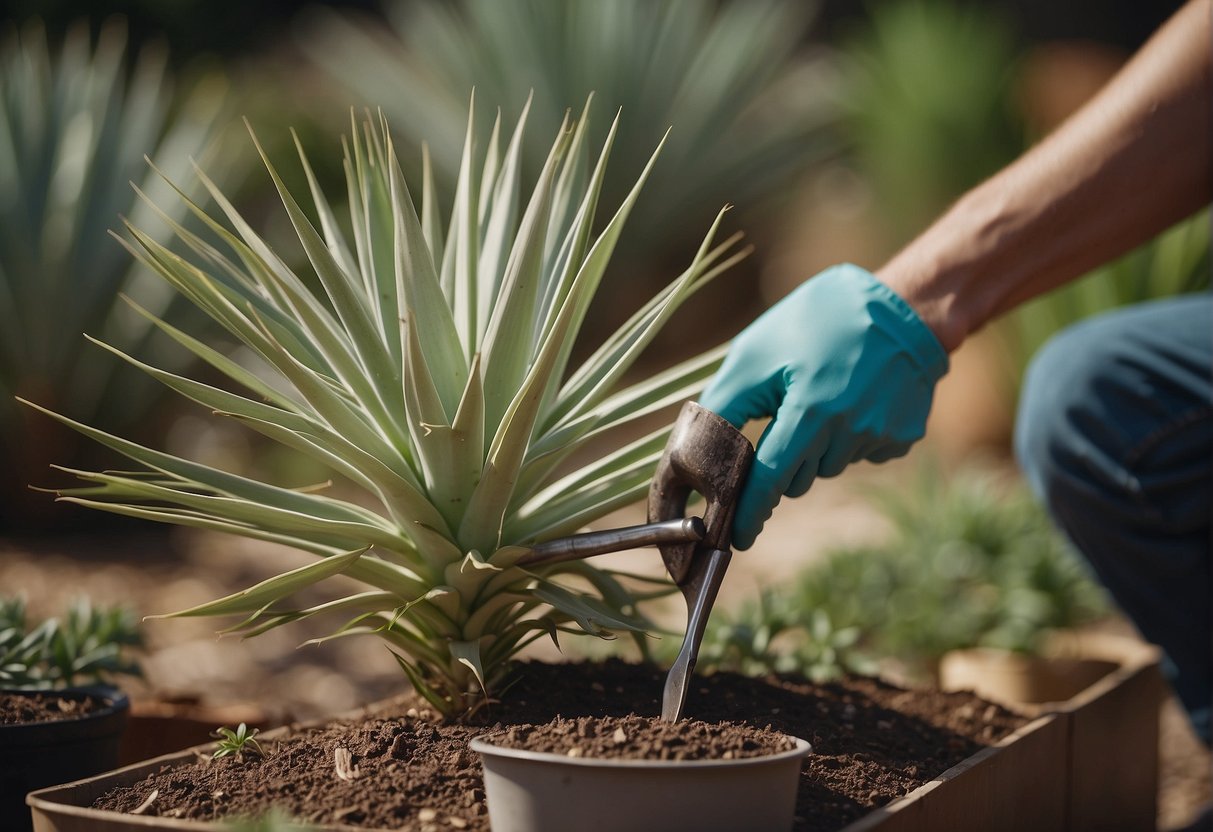How to Divide an Adams Needle Yucca Plant: Expert Tips
Splitting Adams Needle Yucca plants offers an excellent method to both spread your current collection and cultivate new specimens. Initially, the task may appear daunting, but armed with the necessary tools and insights, you can effortlessly separate your yucca plants and reap the rewards of an expanded garden flora. In this guide, we’ll walk you through the steps to successfully split Adams Needle Yucca plants in detail.

Understanding Adams Needle Yucca is crucial before you begin the process of dividing them. These plants are native to the southeastern United States and are known for their sharp, needle-like leaves and tall, spiky blooms. They are drought-tolerant and can thrive in a variety of soil types, making them a popular choice for gardens in many regions. Knowing the characteristics of your Yucca plant will help you determine the best time to divide it and how to care for it after the process.
Propagation of Yucca plants is a simple process that involves dividing the plant’s root system. By doing this, you can create new plants that are genetically identical to the parent plant. Dividing Adams Needle Yucca plants is an effective way to propagate them, and it’s a process that can be done at any time of the year. In the following sections, we will provide you with a step-by-step guide on how to divide your Adams Needle Yucca plants and ensure that they thrive after the process.
Key Takeaways
- Understanding the characteristics of Adams Needle Yucca plants is crucial before dividing them.
- Propagation of Yucca plants involves dividing the root system to create new plants.
- Dividing Adams Needle Yucca plants can be done at any time of the year and is a simple process that can be done with the right tools and knowledge.
Understanding Adam’s Needle Yucca
Botanical Profile
Adam’s Needle Yucca, also known as Yucca filamentosa, is a perennial, evergreen shrub that belongs to the family Asparagaceae. This ornamental plant is native to the United States and is widely used in landscaping due to its low-maintenance and attractive features. The plant has sword-shaped leaves that are green or white, with thread-like filaments on the edges, giving it a unique appearance. The foliage is succulent, which means that the plant can store water in its leaves, making it drought-tolerant.
Ideal Growing Conditions
Adam’s Needle Yucca is a hardy plant that can grow in a wide range of conditions. However, it thrives in well-draining soil that is rich in organic matter. The plant prefers full sun to partial shade and can tolerate a wide range of temperatures. It is hardy to USDA zones 5-10, which means that it can withstand temperatures as low as -20°F.
When planting Adam’s Needle Yucca, it is important to ensure that the soil is well-drained, as the plant does not tolerate wet feet. The plant can be propagated through division, which involves separating the plant into smaller sections and replanting them. This is best done in the spring when the plant is actively growing.
In conclusion, Adam’s Needle Yucca is a beautiful and hardy plant that is perfect for landscaping. It is a low-maintenance plant that can thrive in a wide range of conditions. With its sword-shaped leaves and succulent foliage, it is an excellent addition to any garden.
Propagation of Yucca Plants

Yucca plants are easy to propagate and can be done through division. This is a great way to create new plants and expand your garden. In this section, we will discuss the division process and care after division to ensure successful propagation.
Division Process
To divide an Adams needle yucca plant, start by carefully digging up the entire plant. Use a garden fork to loosen the soil around the plant and gently lift it out of the ground. Shake off any excess soil and remove any dead or damaged leaves.
Next, look for offshoots or basal rosettes that have formed around the main plant. These are the parts that will be divided. Using a sharp, clean knife, cut the offshoots or rosettes away from the main plant. Be sure to leave some roots attached to each new plant.
Once you have divided the plant, replant each section in a well-drained soil mix. Yucca plants prefer sandy soil and full sun, so choose a location that receives plenty of sunlight. Water the newly divided plants thoroughly and continue to water them regularly until they are established.
Care After Division
After dividing your yucca plants, it is important to take care of them properly. Yucca plants are hardy and require minimal maintenance, but they do need some attention to thrive.
Make sure the soil is well-drained and avoid overwatering, as this can lead to root rot. Yucca plants also prefer partial shade in hot climates, so consider planting them in a location that provides some relief from the sun.
Yucca plants are also susceptible to problems such as pests and diseases. Keep an eye out for any signs of damage and treat accordingly. If you notice any yellow or brown leaves, remove them promptly to prevent the spread of disease.
Overall, propagating yucca plants through division is a simple and rewarding process. With the right care and attention, your new plants will thrive and add beauty to your garden.
Caring for Yucca After Planting

After dividing and planting your Adams Needle Yucca plants, it’s important to take proper care of them to ensure their growth and health. Here are some tips on how to care for your Yucca plants after planting.
Watering and Feeding
Yucca plants are drought-tolerant and prefer well-draining soil. Water your newly planted Yucca sparingly, making sure not to over-water as this can lead to root rot. During the summer months, water your Yucca once every two weeks. In the winter, reduce watering to once a month. Fertilize your Yucca with a balanced fertilizer once a year in the spring.
Pruning and Maintenance
Yucca plants require minimal pruning and maintenance. Remove any dead leaves or flower stalks to keep your plant looking neat and tidy. Yucca plants are low-maintenance and do not require regular pruning. However, if your Yucca plant becomes too large, you can trim the top off to control its size.
Yucca plants are generally disease-resistant, but they can be susceptible to mites. If you notice any signs of mites, spray your Yucca with an insecticidal soap. Yucca plants are also known to attract butterflies with their creamy white flowers.
Yucca plants are perfect for xeriscape gardens and can thrive in hot, dry climates. They have sharp leaves, so make sure to plant them away from high-traffic areas. Yucca plants can grow in full sun or partial shade, making them a versatile plant for borders or naturalizing. They are native to the Southwest and Southeast regions of the United States and are commonly found in Florida.
In conclusion, Yucca plants are a drought-tolerant, low-maintenance plant that can add a touch of showiness to your garden with their sword-like leaves and fragrant flower spikes. By following these simple tips, you can ensure the health and longevity of your Yucca plants.
Common Challenges and Solutions
Pest and Disease Management
When propagating Adams needle yucca plants, it is important to keep an eye out for pests and diseases. Yucca moths are a common pest that can damage the plant and reduce its yield. To combat yucca moths, you can use insecticides or attract predators like hummingbirds to your garden.
Diseases like root rot and mites can also pose a threat to your Adams needle yucca plants. To prevent root rot, make sure the soil is well-draining and avoid overwatering. Mites can be controlled with insecticidal soap or neem oil.
Environmental Stress Factors
Adams needle yucca plants are drought-tolerant and can tolerate a range of temperatures, but extreme conditions can still cause problems. In areas with high humidity, the plant may be more susceptible to diseases. In colder climates, the plant may need extra protection during the winter.
Hardiness zones should also be considered when propagating Adams needle yucca plants. Make sure the plant is suitable for your area before planting. If you live in a colder climate, you can grow the plant in a container and move it indoors during the winter.
Overall, by being aware of these common challenges and taking the appropriate measures, you can successfully propagate and maintain healthy Adams needle yucca plants.
Frequently Asked Questions
When is the best time of year to divide Adam’s Needle Yucca?
The best time to divide an Adam’s Needle Yucca is during the spring months, just before the growing season begins. This allows the newly divided plants to establish their roots and adjust to their new environment before the heat of summer arrives.
What is the correct method for dividing a large Yucca plant?
To divide a large Yucca plant, start by digging up the entire plant and carefully removing excess soil from the roots. Then, using a sharp, clean knife or pruning shears, cut the plant into smaller sections, making sure that each section has a healthy root system and at least one shoot or bud. Finally, replant the sections in well-draining soil.
Can you propagate Yucca side shoots, and if so, how?
Yes, you can propagate Yucca side shoots by carefully removing them from the parent plant and planting them in a well-draining soil mix. Make sure to keep the soil moist, but not waterlogged, and provide the new plant with bright, indirect light.
What are the steps to successfully split an indoor Yucca plant?
To successfully split an indoor Yucca plant, start by carefully removing the plant from its container and gently separating the roots. Then, using a clean knife or pruning shears, cut the plant into smaller sections, making sure that each section has a healthy root system and at least one shoot or bud. Finally, replant the sections in fresh soil and water thoroughly.
How should Yucca cuttings be planted for optimal growth?
To plant Yucca cuttings for optimal growth, start by selecting a healthy stem cutting with at least one node. Remove any leaves from the bottom of the cutting and allow it to dry for a few days. Then, plant the cutting in a well-draining soil mix and water lightly. Place the cutting in a bright, indirect light and keep the soil moist until the cutting has established roots.
What are the signs that a Yucca plant is ready to be divided?
The signs that a Yucca plant is ready to be divided include overcrowding of the plant, stunted growth, and a decrease in the number of new shoots or buds. Additionally, if the plant has become too large for its container or is showing signs of stress, it may be time to divide and replant.


